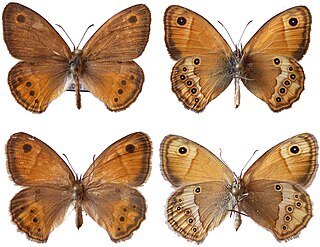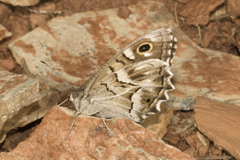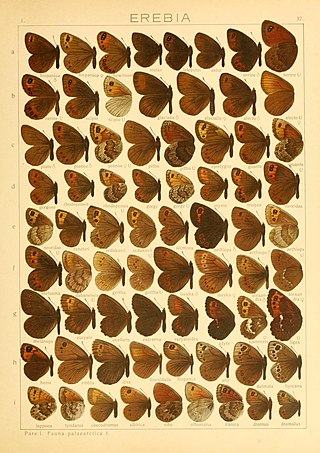
The brown hairstreak is a butterfly in the family Lycaenidae. The range includes most of the Palaearctic.

The purple hairstreak is a butterfly in the family Lycaenidae distributed throughout much of Europe, North Africa, Anatolia, Caucasia, and Transcaucasia. The larva feeds on Quercus robur, Quercus petraea, Quercus cerris and Quercus ilex.

The black hairstreak is a butterfly in the family Lycaenidae.

Cyaniris semiargus, the Mazarine blue, is a Palearctic butterfly in the family Lycaenidae.

Meandrusa sciron, the brown gorgon, is a species of swallowtail butterfly found in parts of South Asia and Southeast Asia. It belongs to the hooked swallowtails genus, Meandrusa, of the family Papilionidae. The brown gorgon is found in India from Sikkim to Assam and north Burma and is not considered to be threatened. Though not uncommon, it is protected under Indian law under the name gyas.

The purple-edged copper is a butterfly of the family Lycaenidae.

The scarce large blue is a species of butterfly in the family Lycaenidae. It is found in Austria, Slovenia, Croatia, the Czech Republic, France, Georgia, Germany, Hungary, Italy, Japan, Kazakhstan, Mongolia, Poland, Romania, Russia, northern Serbia, Spain, Switzerland, and Ukraine and East across the Palearctic to Japan. The species was first described by Johann Andreas Benignus Bergsträsser in 1779.

Scolitantides orion, the chequered blue, is a species of butterfly in the family Lycaenidae. It is found in Europe, Russia and east across the Palearctic to Japan.

Polyommatus escheri, Escher's blue, is a butterfly of the family Lycaenidae. It is found in Southern Europe and Morocco.

Catocala electa, the rosy underwing, is a moth of the family Erebidae. The species was first described by Karl Friedrich Vieweg in 1790. It can be found in Europe and Asia.

Coenonympha dorus, the dusky heath, is a butterfly of the family Nymphalidae. It is found in south-western Europe and North Africa.

Dicallomera fascelina, the dark tussock, is a moth in the family Erebidae. The species was first described by Carl Linnaeus in his 1758 10th edition of Systema Naturae. It is found in most of Europe, through the Palearctic to Central Asia to Korea.

Hipparchia fidia, the striped grayling, is a butterfly of the family Nymphalidae. It is found on the Iberian Peninsula, the Balearic Islands and in south-eastern France and the bordering parts of Italy and North Africa.

Catocala nymphagoga, the oak yellow underwing, is a moth of the family Erebidae. It is found in Southern Europe, from Bulgaria up to the Iberian Peninsula and sometimes further north as a migrant. It is also found in North Africa and Asia Minor.

The shoulder-striped clover is a species of moth of the family Noctuidae. It is found in most of Europe, Ukraine, southern Russia and southern Siberia, Transbaikalia, Turkey, central Asia, China, Japan, the Korean Peninsula, Mongolia, northern India, Pakistan, the Russian Far East.

Jodia croceago, the orange upperwing, is a moth of the family Noctuidae. The species was first described by Michael Denis and Ignaz Schiffermüller in 1775. It is found in southern and central Europe, to the north up to the southern half of England and Wales. According to Warren. W. in Seitz, A. Ed., 1914 also in Algeria, Asia Minor, and Armenia.

Boeberia is a genus of satyrine butterflies containing a single species Boeberia parmenio found in the Altai Mountains South Siberia, Mongolia, Yakutia, Amur and Northeast China.

Japonica lutea is a small butterfly found in the East Palearctic that belongs to the lycaenids or blues family.

Chrysozephyrus smaragdinus is a small butterfly found in the East Palearctic that belongs to the lycaenids or blues family.

Proterebia afra is a small butterfly found in the Palearctic that belongs to the browns family.




















